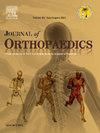Patellar tendon repair restores extensor mechanism function with a low complication rate: A systematic review
IF 1.5
Q3 ORTHOPEDICS
引用次数: 0
Abstract
Introduction
The patellar tendon plays a crucial role in knee extension and lower extremity mobility. Although PT ruptures are rare, they result in severe loss of function when untreated. The purpose of this study was to evaluate clinical and functional outcomes and complications following primary, acute patellar tendon (PT) repair.
Methods
In accordance with Preferred Reporting Items for Systematic Reviews and Meta-Analyses (PRISMA) guidelines, PubMed, Embase, and Cochrane Library databases were searched in August 2024 for studies published after 2004. Studies were included if they met these criteria: evaluated patients who underwent acute PT repair with any technique including for mid-substance tear or avulsion, were prospective or retrospective studies, and reported functional outcomes or complications. Studies not written in English were excluded.
Results
The initial screen identified 1737 studies, 9 of which were included in this systematic review. There were three retrospective cohort studies, three retrospective case series, one retrospective case control study, and two prospective case series. Each study had low risk of bias. A total of 970 patients (93.8 % males) were included. Mean age across studies ranged from 32.1 to 44.6 years. Five included studies reported on mean extension at follow-up, ranging from 0 to 6.4 degrees of extension. Five included studies reported on mean flexion at follow-up, ranging from 128.5 to 143.3 degrees of flexion. The range of re-rupture and re-operation were 0–21.4 % with an overall re-rupture rate of 3.9 % and an overall re-operation rate of 5.7 %. Only one study reported a significant difference in re-rupture rates with transosseous repair versus suture anchor repair (7.5 % versus 0 % respectively). Other complications identified were venous thromboembolism (VTE) (0–5.0 %), stiffness (0–35.0 %), hardware discomfort (0–5.0 %), and infection (0–5.0 %).
Conclusions
Patellar tendon repair with both transosseous and suture anchor technique restores range of motion in patients post-operatively with a low complication rate. Decisions regarding operative technique should be tailored to individual patient characteristics and surgeon preferences.
Level of evidence
Level IV, systematic review of level III-IV studies.
髌腱修复可恢复伸肌机制功能,并发症发生率低:一项系统综述。
髌骨肌腱在膝关节伸展和下肢活动中起着至关重要的作用。虽然PT破裂是罕见的,但如果不治疗,会导致严重的功能丧失。本研究的目的是评估原发性急性髌骨肌腱(PT)修复后的临床和功能结果及并发症。方法:根据系统评价和荟萃分析的首选报告项目(PRISMA)指南,检索PubMed、Embase和Cochrane图书馆数据库,于2024年8月检索2004年以后发表的研究。符合以下标准的研究被纳入:评估了采用任何技术进行急性PT修复的患者,包括中间物质撕裂或撕脱,前瞻性或回顾性研究,并报告了功能结果或并发症。非英文研究被排除在外。结果:初始筛选确定了1737项研究,其中9项纳入本系统综述。有三项回顾性队列研究、三项回顾性病例系列研究、一项回顾性病例对照研究和两项前瞻性病例系列研究。每项研究的偏倚风险都很低。共纳入970例患者,其中93.8%为男性。研究的平均年龄从32.1岁到44.6岁不等。5项纳入的研究报告了随访时的平均伸度,范围从0到6.4度。五项纳入的研究报告了随访时的平均屈曲度,范围从128.5到143.3度。再破裂和再手术的范围为0 ~ 21.4%,总再破裂率为3.9%,总再手术率为5.7%。只有一项研究报告了经骨修复与缝合锚定修复在再破裂率上的显著差异(分别为7.5%和0%)。其他确定的并发症包括静脉血栓栓塞(VTE)(0- 5.0%)、僵硬(0- 35.0%)、硬件不适(0- 5.0%)和感染(0- 5.0%)。结论:髌腱经骨和缝合锚钉联合修复术可恢复患者术后活动范围,并发症发生率低。有关手术技术的决定应根据个别患者的特点和外科医生的喜好进行调整。证据等级:IV级,对III-IV级研究的系统评价。
本文章由计算机程序翻译,如有差异,请以英文原文为准。
求助全文
约1分钟内获得全文
求助全文
来源期刊

Journal of orthopaedics
ORTHOPEDICS-
CiteScore
3.50
自引率
6.70%
发文量
202
审稿时长
56 days
期刊介绍:
Journal of Orthopaedics aims to be a leading journal in orthopaedics and contribute towards the improvement of quality of orthopedic health care. The journal publishes original research work and review articles related to different aspects of orthopaedics including Arthroplasty, Arthroscopy, Sports Medicine, Trauma, Spine and Spinal deformities, Pediatric orthopaedics, limb reconstruction procedures, hand surgery, and orthopaedic oncology. It also publishes articles on continuing education, health-related information, case reports and letters to the editor. It is requested to note that the journal has an international readership and all submissions should be aimed at specifying something about the setting in which the work was conducted. Authors must also provide any specific reasons for the research and also provide an elaborate description of the results.
 求助内容:
求助内容: 应助结果提醒方式:
应助结果提醒方式:


